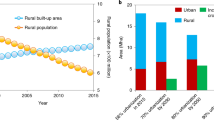Abstract
Since the 1990s, China has entered the middle phase of urbanization which leads to the existence of significant geographic concentration of agricultural land use. The average value of regional concentration degree of ten representative crops in China was 59.03%, showing a high degree of geographic concentration in farming. Some typical agriculture provinces in farming have arisen. The degree of geographic concentration in farming has been enhanced, with the average degree of regional concentration of ten crops increasing considerably by 3.83% in 2009 compared to that in 1990 (55.20%). The spatial growing center of farming was found to move westward and northward during 1990–2009. Meanwhile food production concentrated in the Northeast China and main producing area, and cash crops production concentrated in Northwest China. Off-farm employment of rural labor force, commercialization of agricultural product and regional comparative advantage are the main driving forces of geographic concentration of agricultural land use. Governmental policies with regional differences should be considered to promote further development of agriculture.
Similar content being viewed by others
References
Andreae B (1983). Agrargeographie: Strukturzonen und Betriebsformen in der Weltlandwirtschaft. Berlin: Auflage Walter de Gruyter
ASESOSSB (2011a). China Rural Statistic Yearbook (1991–2010). Beijing: China Statistics Press (in Chinese)
ASESOSSB (2011b). China Yearbook of Rural Household Survey (2001–2010). Beijing: China Statistics Press (in Chinese)
Chen X W (2011). Some issues in the rural development of China. Journal of Nanjing Agricultural University, 11(1): 1–6 (in Chinese)
Huffman W E, Evenson R E (2001). Structural and productivity change in US agriculture, 1950–1982. Agric Econ, 24(2): 127–147
Krugman P (1992). Geography and Trade. Boston: The MIT Press
Krugman P, Venables A (1990). Integration and the competitiveness of peripheral industry. In: Christopher B, Jorge B, eds. Unity with Diversity in the European Economy: the Community’s Southern Frontier. Cambridge: Cambridge University Press, 56–97
Lu W C, Mei Y, Li Y L (2008). Regional change in China’s grain production: effects of labor-land ratio, off-farm employment opportunities and labor compensation. Chin J Popul Sci, 22(3): 20–28 (in Chinese)
Ministry of Agriculture of China (2009). Sixty-year Statistical Data of Agriculture of New China. Beijing: China Agriculture Press (in Chinese)
Pingali P L (1995). Crop-livestock systems for tomorrow’s Asia: from integration to specialization. In: International Workshop 27th on Crop-animal Interaction 1993, Khon Kaen, Thailand. Manila: IRRI Discussion Paper Series, 481–499
RISTI CAAS (1979). Overview of Foreign Agricultural Modernization: United States, Japan, France, West Germany, Holland, the Soviet Union, Hungary. Shanghai: Joint Publishing (in Chinese)
Shen D Q (2010). Factors that Influence the Regional Agricultural Production Structure in China. Dissertation for the Master’s Degree. Washington DC: University of Maryland
Xin L J, Li X B, Tan M H, Hao H G (2011). The rise of ordinary labor wage and its effect on agricultural land use in present China. Geographical Research, 30(8): 1391–1400 (in Chinese)
Zhang K H, Song S F (2003). Rural-urban migration and urbanization in China: evidence from time-series and cross-section analyses. China Econ Rev, 14(4): 386–400
Zheng F T, Gu L P (2006). Quasi-public goods services, role of government and the growth of China’s agricultural industry clusters—case of garlic, Jinxiang County, Shandong Province. China Rural Survey, 22(5): 18–25 (in Chinese)
Zhu Z (1993). Current situation, cause and counter measure of peasant worker movement. Chinese Rural Economy, 9(12): 33–36 (in Chinese)
Author information
Authors and Affiliations
Corresponding author
Additional information
Yuluan ZHAO obtained his B.S. degree in Geography, Guizhou Normal University and M.S. degree in Human Geography, Wuhan University. He is a candidate of Ph. D. in Physical Geography in the Department of Land Cover Change & Land Resources, Institute of Geographic Sciences and Natural Resources Research, Chinese Academy of Sciences. His area of expertise includes land use planning, land sensor, land use/land cover change and land system model.
Dr. Xiubin Li obtained his Ph.D. in the Department of Geography from the University of Hong kong, M.S. degree in the Institute of Geographic Sciences, Chinese Academy of Sciences, and Bachelor’s degree in Geography, Beijing Normal University. He is currently a professor in the Institute of Geographic Sciences and Natural Resources Research, Chinese Academy of Sciences. His research fields include land use and land cover change.
Dr. Liangjie XIN earned his B.A. and M.S. degrees from Shandong Normal University, and received Ph.D. from Graduate University of Chinese Academy of Sciences in 2009. He is an assistant researcher at the Institute of Geographic Sciences and Natural Resources Research, Chinese Academy of Sciences. His research areas include three broad emphases: 1) agricultural land use changes and the effects; 2) land carrying capacity and food security; and 3) rural sustainable development.
Dr. Haiguang HAO obtained his Ph.D. in Physical Geography Sciences from the Institute of Geographic Science and Natural Resources Research (IGSNRR), Chinese Academy of Sciences. He is currently a post-doctoral in the IGSNRR. His main fields of scientific interest include changes of the agricultural labor and agricultural land use, and their impacts on environment in ecological fragile areas.
Rights and permissions
About this article
Cite this article
Zhao, Y., Li, X., Xin, L. et al. Geographic concentration and driving forces of agricultural land use in China. Front. Earth Sci. 6, 48–56 (2012). https://doi.org/10.1007/s11707-012-0303-5
Received:
Accepted:
Published:
Issue Date:
DOI: https://doi.org/10.1007/s11707-012-0303-5




